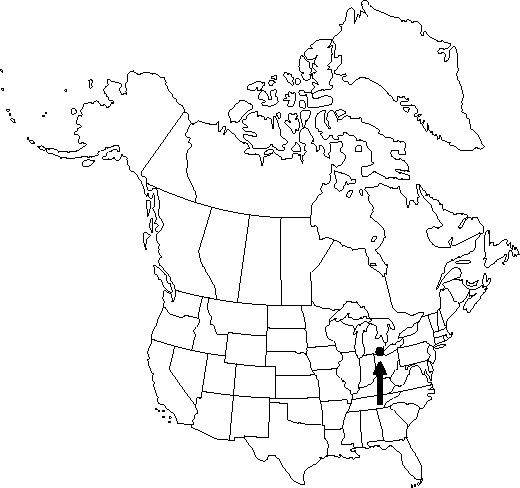Difference between revisions of "Betula murrayana"
Canad. J. Bot. 63: 226. 1985.
FNA>Volume Importer |
imported>Volume Importer |
||
| (6 intermediate revisions by one other user not shown) | |||
| Line 24: | Line 24: | ||
}}<!-- | }}<!-- | ||
| − | --><span class="statement" id="st- | + | --><span class="statement" id="st-undefined" data-properties=""><b>Trees,</b> to 15 m; trunks usually several. <b>Bark</b> of mature trunk and branches dark red to reddish brown, smooth, close; lenticels pale, conspicuous, horizontally expanded. <b>Twigs</b> with taste and odor of wintergreen when crushed, glabrous to sparsely pubescent, covered with small resinous glands. <b>Leaf</b> blade ovate with 7–10 pairs of lateral veins, 5–11 × 3–6 cm, base cuneate, margins sharply and obscurely doubly serrate, apex acute or only slightly acuminate; surfaces abaxially sparsely pubescent to glabrous. <b>Infructescences</b> erect, ovoid, 2–4 × 1.5–3 cm, remaining intact for a period after release of fruits in late fall; scales sparsely pubescent to glabrous, lobes ascending, branching at middle, slightly unequal in length. <b>Samaras</b> with wings narrower than body, broadest near summit, not extended beyond body apically. <b>2n</b> = 112.</span><!-- |
-->{{Treatment/Body | -->{{Treatment/Body | ||
| Line 32: | Line 32: | ||
|distribution=Mich. | |distribution=Mich. | ||
|discussion=<p>Of conservation concern.</p><!-- | |discussion=<p>Of conservation concern.</p><!-- | ||
| − | --><p>Betula murrayana is an octoploid derivative of Betula × purpusii (= B. alleghaniensis Britton × B. pumila Linnaeus) (B. V. Barnes and B. P. Dancik 1985). It is intermediate between B. alleghaniensis and B. pumila in most vegetative features, but in characters such as leaf size, it approaches B. alleghaniensis.</p> | + | --><p><i>Betula murrayana</i> is an octoploid derivative of <i>Betula</i> × purpusii (= <i>B. alleghaniensis</i> Britton × <i>B. pumila</i> Linnaeus) (B. V. Barnes and B. P. Dancik 1985). It is intermediate between <i>B. alleghaniensis</i> and <i>B. pumila</i> in most vegetative features, but in characters such as leaf size, it approaches <i>B. alleghaniensis</i>.</p> |
|tables= | |tables= | ||
|references= | |references= | ||
| Line 41: | Line 41: | ||
-->{{#Taxon: | -->{{#Taxon: | ||
name=Betula murrayana | name=Betula murrayana | ||
| − | |||
|authority=B. V. Barnes & Dancik | |authority=B. V. Barnes & Dancik | ||
|rank=species | |rank=species | ||
| Line 56: | Line 55: | ||
|publication year=1985 | |publication year=1985 | ||
|special status=Conservation concern;Endemic | |special status=Conservation concern;Endemic | ||
| − | |source xml=https:// | + | |source xml=https://bibilujan@bitbucket.org/aafc-mbb/fna-data-curation.git/src/bb6b7e3a7de7d3b7888a1ad48c7fd8f5c722d8d6/coarse_grained_fna_xml/V3/V3_45.xml |
|subfamily=Betulaceae subfam. Betuloideae | |subfamily=Betulaceae subfam. Betuloideae | ||
|genus=Betula | |genus=Betula | ||
|species=Betula murrayana | |species=Betula murrayana | ||
| − | |||
| − | |||
| − | |||
| − | |||
| − | |||
| − | |||
| − | |||
| − | |||
| − | |||
| − | |||
| − | |||
| − | |||
| − | |||
| − | |||
| − | |||
| − | |||
| − | |||
| − | |||
| − | |||
| − | |||
| − | |||
| − | |||
| − | |||
| − | |||
| − | |||
| − | |||
| − | |||
| − | |||
| − | |||
| − | |||
| − | |||
| − | |||
| − | |||
}}<!-- | }}<!-- | ||
-->[[Category:Treatment]][[Category:Betula]] | -->[[Category:Treatment]][[Category:Betula]] | ||
Revision as of 00:01, 28 May 2020
Trees, to 15 m; trunks usually several. Bark of mature trunk and branches dark red to reddish brown, smooth, close; lenticels pale, conspicuous, horizontally expanded. Twigs with taste and odor of wintergreen when crushed, glabrous to sparsely pubescent, covered with small resinous glands. Leaf blade ovate with 7–10 pairs of lateral veins, 5–11 × 3–6 cm, base cuneate, margins sharply and obscurely doubly serrate, apex acute or only slightly acuminate; surfaces abaxially sparsely pubescent to glabrous. Infructescences erect, ovoid, 2–4 × 1.5–3 cm, remaining intact for a period after release of fruits in late fall; scales sparsely pubescent to glabrous, lobes ascending, branching at middle, slightly unequal in length. Samaras with wings narrower than body, broadest near summit, not extended beyond body apically. 2n = 112.
Phenology: Flowering late spring.
Habitat: Wet, swampy forests containing Betula pumila
Elevation: 0–300 m
Discussion
Of conservation concern.
Betula murrayana is an octoploid derivative of Betula × purpusii (= B. alleghaniensis Britton × B. pumila Linnaeus) (B. V. Barnes and B. P. Dancik 1985). It is intermediate between B. alleghaniensis and B. pumila in most vegetative features, but in characters such as leaf size, it approaches B. alleghaniensis.
Selected References
None.
